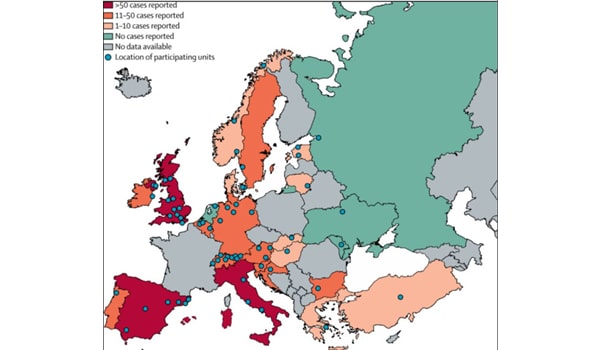
Top image: Location of participating units and number of paediatric cases reported by country
Lancet Child & Adolescent Health 25 June 2020 (Open access)
by Florian Götzinger, Begoña Santiago-García, Antoni Noguera-Julián, Miguel Lanaspa, Laura Lancella, and many others on behalf of the ptbnet Covid-19 Study Group
[This very technical abstract is simplified for ease of understanding. The two main reasons it was important to share this information is first, to show that children do get Covid-19 and are therefore a potential source of infection of each other and the adults in their lives. This has implications for opening schools during the pandemic, for example. Secondly, only a small proportion of children develop severe disease, and death is rare, which is good news. Editor]
Background and methods
This multicentre cohort study involved 82 participating health-care institutions across 25 European countries, using a well-established research network – the Paediatric Tuberculosis Network European Trials Group (ptbnet) – that mainly comprises paediatric infectious diseases specialists and paediatric pulmonologists. We included all individuals aged 18 years or younger with confirmed Covid-19 infection, detected in any part of the body by RT-PCR (an accurate, rapid means of testing), between 1–24 April 2020, during the initial peak of the European Covid-19 pandemic. We explored factors associated with need for admission to the intensive care unit (ICU) and initiation of drug treatment for Covid-19… [using relevant forms of analysis] to further explore those factors significantly associated with ICU admission.
Findings
582 children with confirmed Covid-19 infection were included (Figure 1), with a median age of 5·0 years, mainly ages 6 months to 12 years, and a sex ratio of 1·15 males per female. 145 (25%) had pre-existing medical conditions. 363 (62%) were admitted to hospital. 48 (8%) required Intensive Care Unit admission, 25 (4%) mechanical ventilation (median duration 7 days, main range 2–11, range 1–34), 19 (3%) inotropic support, and one (<1%) prolonged cardiac and respiratory support.
Significant risk factors for requiring ICU admission in multivariable analyses were being younger than 1 month (odds ratio 5·06, 95% CI 1·72–14·87; p=0·0035), male sex (2·12, 1·06–4·21; p=0·033), pre-existing medical conditions (3·27, 1·67–6·42; p=0·0015), and presence of lower respiratory tract infection signs or symptoms at presentation (10·46, 5·16–21·23; p<0·0001)…. Four children had died (case-fatality rate 0·69%, 95% CI 0·20–1·82) by study end, the remaining 578 were alive and only 25 (4%) were still symptomatic or requiring respiratory support.
Interpretation
COVID-19 is generally a mild disease in children, including infants. However, a small proportion develop severe disease requiring ICU admission and prolonged ventilation, although fatal outcome is overall rare. The data also reflect the current uncertainties regarding specific treatment options, highlighting that additional data on antiviral and immunomodulatory drugs are urgently needed.



